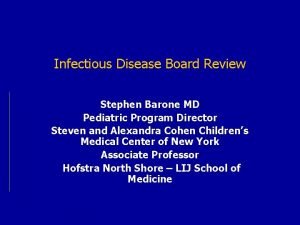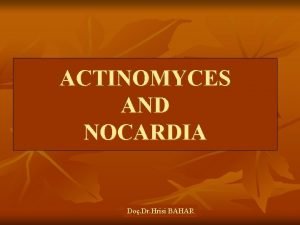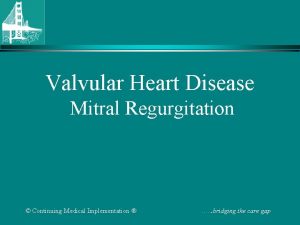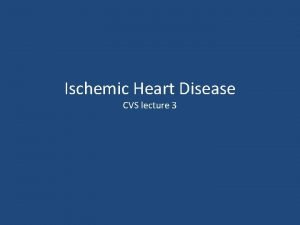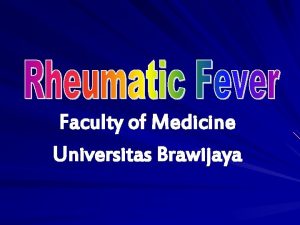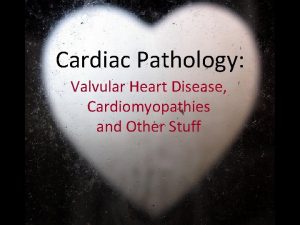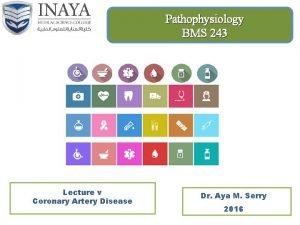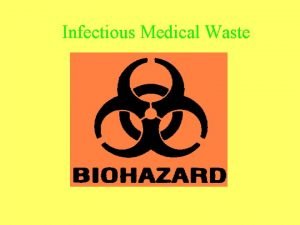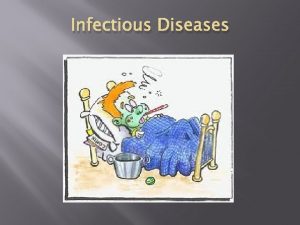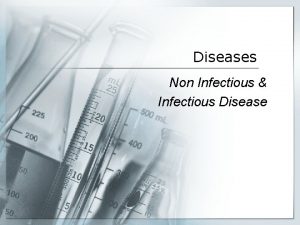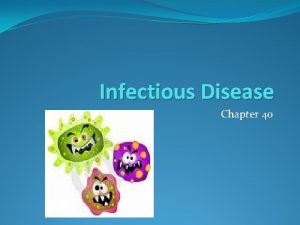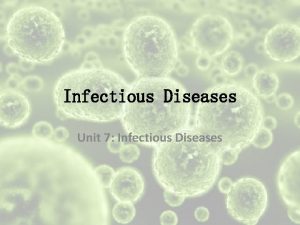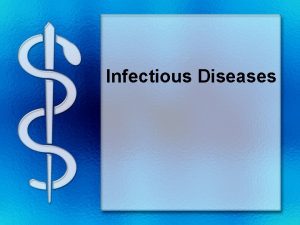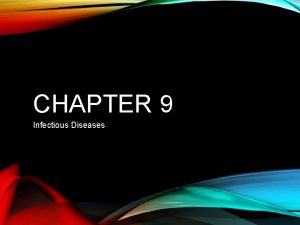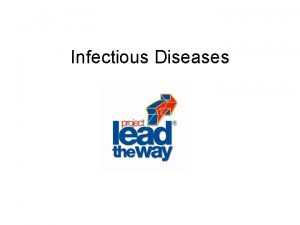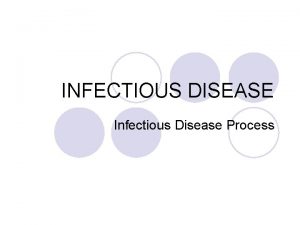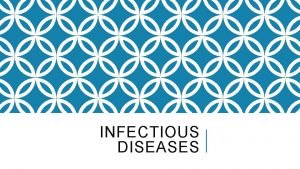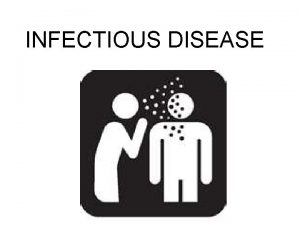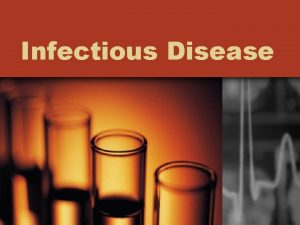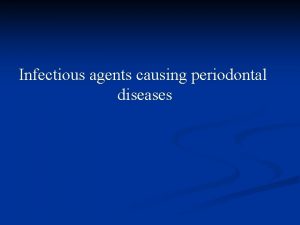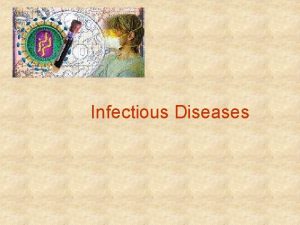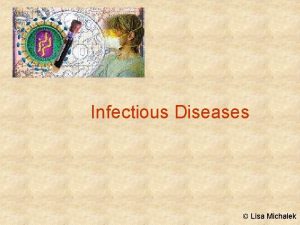Disease Causing Organisms Pathophysiology Study of Diseases Infectious






















- Slides: 22

Disease Causing Organisms

Pathophysiology – Study of Diseases • Infectious Disease Causing Categories • Degenerative Diseases • Nutritional Disorders • Metabolic Disorders • Immune Disorders • Neoplasms • Psychiatric Disorders

• Age • Gender • Heredity Causes of Disease • Living conditions and habits • Emotional Disturbance • Physical & Chemical Damage • Idiopathic-Disease without a known cause. • Iatrogenic-Disease results from adverse effects of treatment.

Epidemiology is the study (scientific, systematic, and data-driven) of the distribution (frequency, pattern) and determinants (causes, risk factors) of healthrelated states and events (not just diseases) in specified populations (neighbourhood, school, city, state, country, global).

Epidemiology –Study of diseases in populations. • Incidence Epidemiology • Prevalence • Mortality Rate • Epidemic • Endemic • Pandemic

• Diagnosis – Symptoms & Signs Disease Diagnosis, Treatment & Prevention - Syndrome - Acute, Chronic & Sub Acute - Prognosis & Diagnosis • Treatment – Physical Therapy - Occupational Therapy - Nutritional Therapy - Counselling & Support

Complementary & Alternative Medicine • Complementary and Alternative Medicine. Complementary and alternative medicine includes practices such as massage, acupuncture, tai chi, and drinking green tea. • Complementary and alternative medicine (CAM) is the term for medical products and practices that are not part of standard medical care.

• Naturopathy Complementary & Alternative Medicine Types • Chiropractic • Acupuncture • Biofeedback • Exercise, Massage, Yoga, Meditation and Nutritional Counseling

Disease Prevention • Disease prevention is a procedure through which individuals, particularly those with risk factors for a disease, are treated in order to prevent a disease from occurring. • Treatment normally begins either before signs and symptoms of the disease occur, or shortly thereafter

• Cessation of Tobacco use Disease Prevention • Limiting Alcohol use • Nourishing Diet • Healthy Weight • Regular Exercise

Infectious Disease • Infectious diseases are caused by pathogenic microorganisms, such as bacteria, viruses, parasites or fungi; the diseases can be spread, directly or indirectly, from one person to another.

• Micro-organism • Parasite Infectious Disease • Pathogen • Infection • Systemic • Opportunistic Infection

Microbiology –Study of Microorganisms • Bacteria –Cocci, Bacilli, Curved rods • Viruses – Affect RNA & DNA • Fungi • Prozoa • Algae

Normal Flora • Normal flora is the term used to describe the various bacteria and fungi that are permanent residents of certain body sites, especially the skin, oropharynx, colon, and vagina • Normal Flora – grows on or within our bodies • Beneficial in helping to break down food residues • Help producing vitamin K

Bacteria • Bacteria are microscopic, single-celled organisms that exist in their millions, in every environment, both inside and outside other organisms. • Some bacteria are harmful, but most serve a useful purpose. They support many forms of life, both plant and animal, and they are used in industrial and medicinal processes. • Gram Staining • Anaerobic • Aerobic • Endospores • Pili – assist in movement • Shapes - Cocci, Bacilli & Curved Roads

• Virus: A microorganism that is smaller than a bacterium that cannot grow or reproduce apart from a living cell. Viruses • A virus invades living cells and uses their chemical machinery to keep itself alive and to replicate itself. It may reproduce with fidelity or with errors (mutations); this ability to mutate is responsible for the ability of some viruses • Contain genetic material • Able to reproduce • Viruses are named according to where they were isolated.

• Parasitic worms are small animals which can live inside the body. Their eggs are taken into the body, usually by swallowing. The worms then hatch out of the eggs and live in the body. Some types of worm larvae (young worms) can also burrow their way into the body through the skin. Parasitic Worms • Also known as Helminths • Round worms • Hook worms • Flat worms

Microbes and Public Health • Sewage & Garbage Disposal • Water purification • Prevention of food contamination • Milk Pasteurisation

• Aseptic technique means using practices and procedures to prevent contamination from pathogens. Aseptic Methods • It involves applying the strictest rules to minimize the risk of infection. Healthcare workers use aseptic technique in surgery rooms, clinics, outpatient care centres, and other health care settings.

Medical Terminology • Pan- All • Syn- Together • Diplo- Double • -cide kill or destroy

• Ross & Wilson Anatomy & Physiology (2014) 12 th ed. A, & Grant A. , Churchill Livingstone Elsevier References • Memmlers The Human Body In Health and Disease (2013) 12 th Lippincott Williams & Wilkins • Andrew Huttons – An Introduction to Medical Terminology for Health Care-Self teaching package – (2017) 5 th ed.

The End
 Icd 10 morbus hansen
Icd 10 morbus hansen Epidemiological triad of malaria
Epidemiological triad of malaria Infectious disease quality controls
Infectious disease quality controls Types of infection
Types of infection Chapter 26 infectious disease prevention and control
Chapter 26 infectious disease prevention and control Stages of infectious disease
Stages of infectious disease Infectious disease board review
Infectious disease board review Infectious disease
Infectious disease Hennepin county infectious disease manual
Hennepin county infectious disease manual Viruses are the smallest infectious agents
Viruses are the smallest infectious agents Pathophysiology of hirschsprung disease
Pathophysiology of hirschsprung disease Pathophysiology of valvular heart disease
Pathophysiology of valvular heart disease Site:slidetodoc.com
Site:slidetodoc.com Pathophysiology of ischemic heart disease
Pathophysiology of ischemic heart disease Pathophysiology of valvular heart disease
Pathophysiology of valvular heart disease Right sided heart failure
Right sided heart failure Pathophysiology of valvular heart disease
Pathophysiology of valvular heart disease Coronary artery disease pathophysiology
Coronary artery disease pathophysiology Competitive interaction
Competitive interaction Multicellular organisms and unicellular organisms
Multicellular organisms and unicellular organisms Bharathi viswanathan
Bharathi viswanathan Define infectious waste
Define infectious waste Infectious canine hepatitis in dogs
Infectious canine hepatitis in dogs






